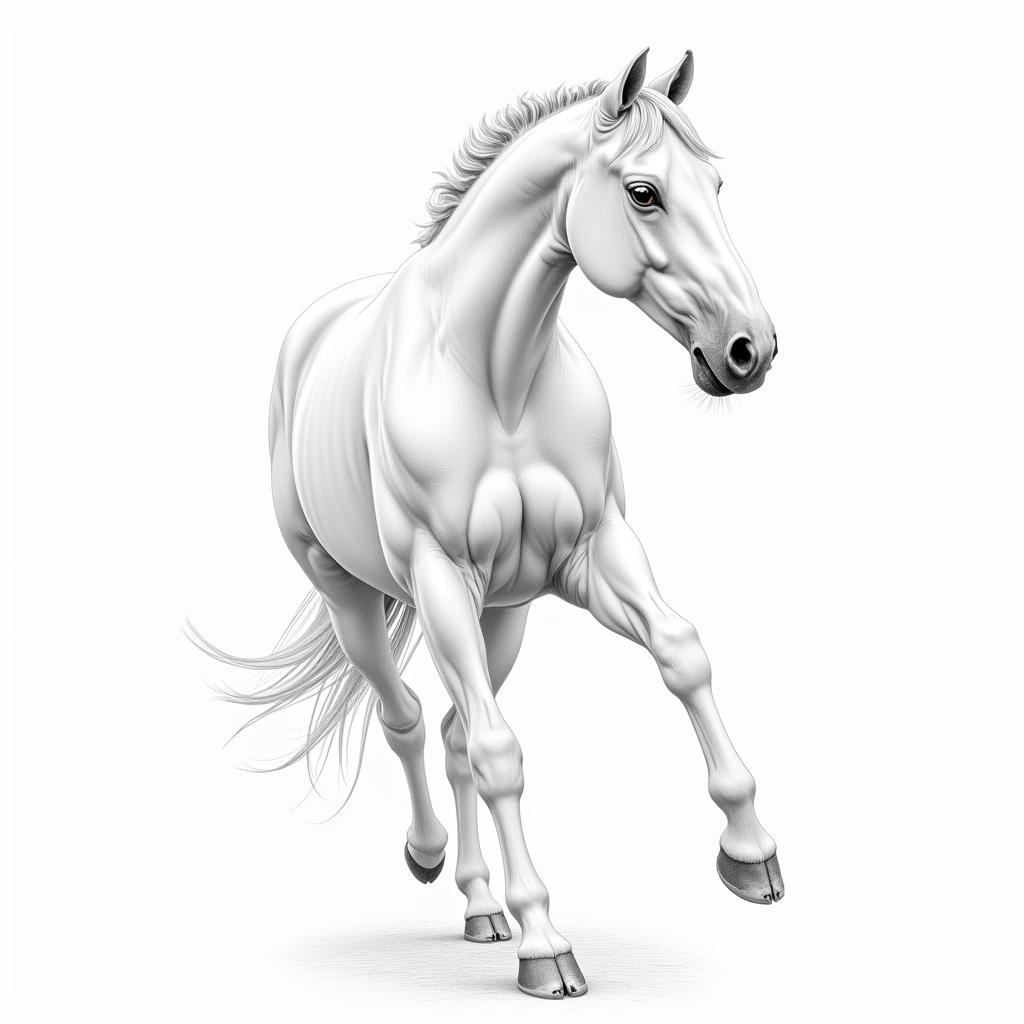The allure of white horses has captivated artists for centuries. Their pristine beauty and symbolism have inspired countless masterpieces, from majestic landscapes to captivating portraits. Whether you’re a seasoned artist or just starting out, learning to draw a white horse is a rewarding experience. In this article, we’ll explore the artistic techniques and considerations involved in capturing the essence of these magnificent creatures on paper.
Understanding the Anatomy of a White Horse
Before you grab your pencil, it’s essential to understand the basic anatomy of a horse. This knowledge will help you create a realistic and balanced drawing. Pay close attention to the proportions of the head, neck, body, and legs. Observe the muscular structure, especially the powerful hindquarters and the graceful neck. You can use reference images, anatomy guides, or even visit a local stable to observe real horses.
Creating a Realistic White Horse Drawing
To capture the captivating beauty of a white horse in your drawing, consider these techniques:
1. Start with a Basic Outline: Begin by sketching a light outline of the horse’s body using a pencil. This will serve as your foundation and allow for adjustments as you progress.
2. Define the Form with Shading: Use shading techniques to create volume and dimension. Start with a light layer of shading, gradually darkening the areas where shadows fall. Pay attention to the horse’s musculature and how light interacts with its form.
3. Highlighting the Details: To create a more detailed and realistic drawing, use a fine-tipped pencil to emphasize the horse’s facial features, mane, and tail. This will give your drawing a sense of depth and texture.
4. Adding Subtlety and Texture: White horses are often considered ethereal and delicate. You can enhance their beauty by adding subtle details like wrinkles, creases, and the subtle texture of their coat.
5. Incorporating the Background: The background plays a crucial role in setting the tone of your drawing. Consider incorporating elements like landscapes, skies, or even other animals to create a harmonious and engaging composition.
Tips for Drawing a White Horse
Here are some tips from professional artist, Jonathan “J.D.” Davies, who specializes in animal portraiture:
“Don’t be afraid to experiment with different drawing tools. Try using charcoal, pastels, or even colored pencils to add depth and texture to your White Horse Drawing.”
“When drawing a white horse, pay attention to the nuances of white. Use various shades and tones to create a sense of depth and dimension. A pure white horse can be quite stunning, but remember that even white horses have subtle variations in their coat.”
Common Mistakes to Avoid
Here are some common mistakes to avoid when drawing a white horse:
- Over-Shading: Too much shading can make your white horse appear dark and muddy. Use light layers and observe the way light interacts with the horse’s form.
- Unrealistic Proportions: Ensure that the horse’s anatomy is accurate. Use reference images or anatomy guides to ensure that the proportions of the head, neck, body, and legs are balanced.
- Lack of Detail: While it’s essential to avoid over-shading, don’t forget to add details like the horse’s facial features, mane, and tail. These elements will add realism and life to your drawing.
Inspiration for White Horse Drawings
Looking for inspiration? Here are some famous examples of white horse drawings:
- The White Horse of Uffington: This iconic chalk hill figure in England dates back to the Bronze Age. It’s a testament to the enduring power of the white horse as a symbol.
- “The White Horse” by Franz Marc: This iconic painting from the Expressionist movement captures the ethereal beauty of a white horse in a vibrant and abstract style.
- “The White Horse” by Winslow Homer: This captivating water color depicts a white horse galloping across a beach, capturing the energy and grace of these magnificent animals.
Frequently Asked Questions
Q: What are some good reference images for drawing white horses?
A: You can find excellent reference images online, in books, or even by visiting a local stable.
Q: What are the best pencils for drawing white horses?
A: A range of pencils is useful. Start with a 2H pencil for light outlines and progress to softer pencils like 2B or 4B for shading and adding detail.
Q: How can I add texture to my white horse drawing?
A: Use a variety of shading techniques, cross-hatching, stippling, or even blending to add texture to your white horse’s coat.
Conclusion
Drawing a white horse is an exciting journey into capturing the essence of beauty and grace. By understanding the anatomy, experimenting with techniques, and drawing inspiration from the masters, you can create a captivating drawing that celebrates these magnificent creatures. Remember to practice regularly, observe carefully, and never stop exploring the endless possibilities of artistic expression.
Ready to unleash your artistic potential and bring your white horse drawing to life? Start your journey today!



Need assistance or have more questions? Reach out to us at:
- Phone: 0772127271
- Email: [email protected]
- Address: QGM2+WX2, Vị Trung, Vị Thuỷ, Hậu Giang, Việt Nam
We have a dedicated team ready to assist you 24/7.